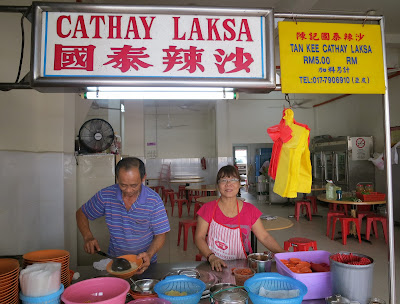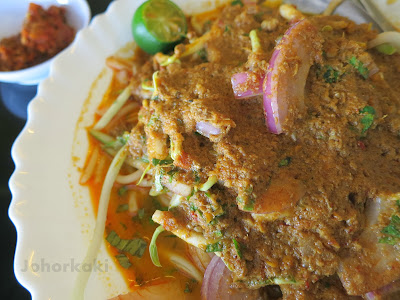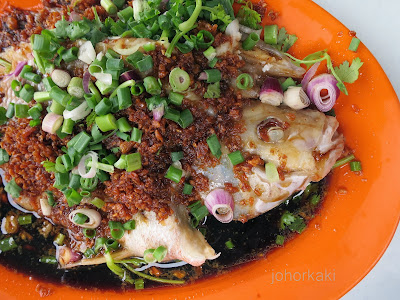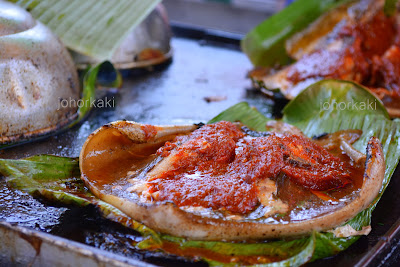
Cathay Laksa
Cathay Laksa is one of the well loved old styled curry laksa brands in Johor Bahru. There are two stalls using the "Cathay Laksa" brand. One at Jalan Lumba Kuda and the other at an alley known as Siak Hong off Jalan Tebrau. The phrase Cathay Laksa came from the name of the Johor Bahru's most famous cinema in downtown JB, The Cathay, before it was demolished to make way for the CIQ (Immigration Complex) building. The curry laksa stall was named after Cathay cinema as it was located near to it. The cinema is gone but the Cathay Laksa stall is still there to remind us of where The Cathay once stood.

Chai Tow Kway
Chai Tow Kway 菜头粿 - This common street food usually eaten at breakfast is made with steamed rice flour and Chinese radish. The large rectangular slabs of chai tow kway are cut into small bite size pieces on a hot wok and stir-fried with eggs, chopped pickled radish, and seasonings like dark soy sauce.

Curry Fish Head
Curry Fish Head (Chinese Style) - Curry fish head is a popular dish in Singapore and Malaysia, available in various styles. In the Chinese style, the fresh fish head is kept chilled until an order is received. The fresh fish head is then poached by dunking it in boiling water. The curry is cooked separately with coconut milk, ground dried shrimps and various spices such as turmeric, dried chili and so on. The poached fish is transferred to a claypot which is then filled with curry and cooked for a few more minutes. Fresh vegetables such as Lady's Fingers, eggplant, long beans and cabbages are cooked together with the poached fish and curry. The popular curry fish heads have tender and sweet flesh, and the gelatinous tissues around the mouth and eyes are still soft and slippery. The vegetables are crunchy and the curry is mildly spicy.

Curry Laksa
Curry Laksa - A Southeast Asian fusion with many variations found in Malaysia and Singapore. In one version popular in Johor Bahru, the curry base is made with anchovy and soy bean broth the same way as the soup for kway teow soup or wanton mee is made. To this broth, coconut milk and a mix of curry spices such as dried chilis and turmeric are added. Curry laksa is served with fresh and fried toufu, fish balls, fresh cockles, bean sprouts and other ingredients. Curry laksa is eaten with yellow noodles, and both the thin and thick versions of bee hoon.

Chicken Rice
Chicken Rice 鸡饭 - It is no exaggeration to say that chicken rice is found in every corner of Singapore and Malaysia. The best chicken are poached till they are just done so that the flesh is tender and juicy, and retains the natural flavours of the bird. The chicken is served drizzled with blended light soy sauce and often sesame oil (I like). Of course, chicken rice is served with rice :P - in a plate or a small rice bowl. Good chicken rice is boiled with real chicken stock, chicken fat, fragrant pandan leaves, garlic, ginger and lemon grass (serai). You can just imagine the resulting steaming aromatic fluffy rice that comes out of the pot. Also important are the dips. Freshly ground blend of red chili and garlic, and ginger are the best. Some people also like to eat chicken rice with tacky, savoury dark soy sauce.

Laksa Johor
Laksa Johor is a truly unique Johor dish. It is spaghetti, yes that Italian pasta, soaked and blanketed in a thick, gritty gravy made with ground fish such as Ikan Parang and a complex blend of herbs, vegetables, fresh juices, dried shrimps and spices. Good Laksa Johor has the al dente bite of good spaghetti. The gravy is fragrant from all the herbs and spices. The taste is savoury from the ground fish and it has juicy, crunchy bits like salad. There is a touch of tanginess and mild spiciness. According to legend, Johor Laksa was created by Sultan Abu Bakar in the 1800s. During the Sultan's visit to Italy and Europe, he fell in love with Bologna's spaghetti. When Sultan Abu Bakar returned to Johor, he instructed the Palace chefs to make laksa with spaghetti and presto, Laksa Johor was invented.

Lor Mee
Lor Mee 鹵麵 - Yellow noodles served in a starchy savoury gravy made with prawn and bone broth. It is the same umami flavoured broth as that in Penang prawn mee but with starch added to produce the gooey gravy. Garnished with shelled prawns, boiled egg, ngo hiang (Hokkien meat roll) and slices of braised or boiled pork. Eaten with vinegar, chopped garlic or cut fresh chili as condiments.

Mee Hoon Kueh
Mee Hoon Kueh 面粉粿 is a Chinese (Hokkien) dish. The kueh are irregular, hand torn, translucent pieces of dough made mainly with hand kneaded wheat flour with eggs. The texture of the best mee hoon kueh has a gummy, tender outside with a subtly stiff core inside. It is served in soup or in dry form tossed in a soy based sauce with shallot oil and chili paste. Good mee hoon kueh soup is made by boiling large stock pork bones (e.g. socket joints) and anchovies for many hours. The soup has good body and a seductive umami (savoury) flavour. Mee Hoon Kueh is served with pork balls, fried anchovies, sayur manis (a leafy green) and often with a raw egg thrown in.

Nasi Lemak
Nasi Lemak - A popular favourite, nasi lemak is rice cooked in coconut milk and often enhanced with fragrant herbs and spices like pandan leaves. Nasi lemak is usually eaten with sambal chili, an egg, slices of cucumber, fried peanut and anchovies. It is common to eat nasi lemak with side dishes such as fried chicken, fish or cuttlefish.

Petai
Petai - A flat and thumbnail sized green coloured bean. It has a pungent smell hence it is known as "Smelly Beans" 臭豆 in Chinese. It's taste is slightly bitter and it's texture crunchy and slightly waxy. An acquired taste that is well loved locally, it is eaten raw with sambal chili dip or stir fried with sambal, onions and anchovies (as in the picture).

Poached Fish
Poached Fish - A dish named after it's cooking technique - which is to dunk the fresh fish in a large pot of boiling water. The cooked fish is then drenched in a drippy light soy sauce and shallot oil based gravy. The tender and sweet fish is next topped with a generous shower of fried chopped garlic and a sprinkle of fresh spring onions. So far in JB, I know only of Hin Hock that serves this delightful dish.

Ikan Bakar
Ikan Bakar 烧鱼 - Literary means grilled fish. Ikan Bakar stalls both Malay and Chinese not just grill fish - they also grill other seafood like squids, shellfish and vegetables. The most popular are grilled stingrays. In Malaysia and Singapore, the fresh fish is laid on a banana leaf and cooked on a greasy flat gas fired iron griddle, often oiled with margarine. When nearly cooked, the fish is topped with a blanket of sambal, covered and allowed to simmer for a few minutes. Every stall have their special blend of sambal made with chili, onions, and other spices. Often, besides the freshness of the seafood, it is the sambal that differentiates the stalls. So the sambal recipe is a closely guarded secret. The better stalls use over 20 ingredients to make their sambal. Good Ikan Bakar is flavourful and the seafood is cooked to just done. The fish's sweet juices are still intact and the flesh remains moist and tender.

Beef Rendang
Rendang - Rendang is made with beef or chicken. The meat is slow cooked in coconut milk and spices until the liquid is reduced to a thick, spicy, savoury gravy. Most of the ingredients are infused deep into the meat fibres. Good rendang is tender and the meat is perfumed with the aroma of coconut and spices. Redang is usually eaten with rice at nasi padang stalls.

Roti Canai or Prata
Roti Canai - Known as roti prata in Singapore, this is an Indian pancake made with wheat flour. The dough oiled with margarine is stretched by tossing and flipping. The stretched dough is then folded and fried on a flat iron griddle. Good roti canai is crispy on the outside while the folds inside are softer. Roti canai is eaten by dipping in curry and in Malaysia, a dollop of sambal chili is often added.

San Low Bee Hoon 三楼炒米粉
San Low Bee Hoon 三楼炒米粉 is a unique dish invented in Johor Bahru. It is really a variation of the ordinary fried bee hoon executed with mastery of wok fire that makes it special. San Low bee hoon is presented flattened and the outer layer of the bee hoon is slightly charred. Overall, the bee hoon is dry but not stringy. The savoury bee hoon is fried in seafood broth with small pieces of shrimps, squid, lean pork, eggs and choy sum (green vegetable). The inner bee hoon strands retain a little moistness from the seafood broth it is fried in. Served with chili paste blended with dried shrimps (sambal).

Teh Tarik
Teh Tarik - Literary "pulled tea". For many people, a teh tarik is a must have with mee rebus, roti canai, nasi lemak, satay or just about any Malay or Indian dish. Teh tarik is brewed from dried tea leaves, add a large dollop of evaporated milk and then pulled by transferring it between containers to naturally aerate the tea. The longer the tea maker can stretch the tea, the better it is aerated. Good teh tarik is served fragrant, hot and frothy.

Pontian Wanton Mee 笨珍云吞面
Wanton Mee (Pontian style) that originates from the Johor coastal town of Pontian 笨珍云吞面, differentiates itself from other variations by its unique sauce which is a blend of tomato ketchup, chili sauce, oyster sauce, soy sauce and vegetable/shallot oil. The sauce is a complex mix of sweet, savoury, tangy and spicy flavours. Another unique feature is that it is served with fishballs, in addition to the usual wantons. Pontian style wanton mee has it's fans and detractors, both of whom can be forthright about their sentiments.

Cathay Laksa
Cathay Laksa is one of the well loved old styled curry laksa brands in Johor Bahru. There are two stalls using the "Cathay Laksa" brand. One at Jalan Lumba Kuda and the other at an alley known as Siak Hong off Jalan Tebrau. The phrase Cathay Laksa came from the name of the Johor Bahru's most famous cinema in downtown JB, The Cathay, before it was demolished to make way for the CIQ (Immigration Complex) building. The curry laksa stall was named after Cathay cinema as it was located near to it. The cinema is gone but the Cathay Laksa stall is still there to remind us of where The Cathay once stood.

Chai Tow Kway
Chai Tow Kway 菜头粿 - This common street food usually eaten at breakfast is made with steamed rice flour and Chinese radish. The large rectangular slabs of chai tow kway are cut into small bite size pieces on a hot wok and stir-fried with eggs, chopped pickled radish, and seasonings like dark soy sauce.

Curry Fish Head
Curry Fish Head (Chinese Style) - Curry fish head is a popular dish in Singapore and Malaysia, available in various styles. In the Chinese style, the fresh fish head is kept chilled until an order is received. The fresh fish head is then poached by dunking it in boiling water. The curry is cooked separately with coconut milk, ground dried shrimps and various spices such as turmeric, dried chili and so on. The poached fish is transferred to a claypot which is then filled with curry and cooked for a few more minutes. Fresh vegetables such as Lady's Fingers, eggplant, long beans and cabbages are cooked together with the poached fish and curry. The popular curry fish heads have tender and sweet flesh, and the gelatinous tissues around the mouth and eyes are still soft and slippery. The vegetables are crunchy and the curry is mildly spicy.

Curry Laksa
Curry Laksa - A Southeast Asian fusion with many variations found in Malaysia and Singapore. In one version popular in Johor Bahru, the curry base is made with anchovy and soy bean broth the same way as the soup for kway teow soup or wanton mee is made. To this broth, coconut milk and a mix of curry spices such as dried chilis and turmeric are added. Curry laksa is served with fresh and fried toufu, fish balls, fresh cockles, bean sprouts and other ingredients. Curry laksa is eaten with yellow noodles, and both the thin and thick versions of bee hoon.

Chicken Rice
Chicken Rice 鸡饭 - It is no exaggeration to say that chicken rice is found in every corner of Singapore and Malaysia. The best chicken are poached till they are just done so that the flesh is tender and juicy, and retains the natural flavours of the bird. The chicken is served drizzled with blended light soy sauce and often sesame oil (I like). Of course, chicken rice is served with rice :P - in a plate or a small rice bowl. Good chicken rice is boiled with real chicken stock, chicken fat, fragrant pandan leaves, garlic, ginger and lemon grass (serai). You can just imagine the resulting steaming aromatic fluffy rice that comes out of the pot. Also important are the dips. Freshly ground blend of red chili and garlic, and ginger are the best. Some people also like to eat chicken rice with tacky, savoury dark soy sauce.

Laksa Johor
Laksa Johor is a truly unique Johor dish. It is spaghetti, yes that Italian pasta, soaked and blanketed in a thick, gritty gravy made with ground fish such as Ikan Parang and a complex blend of herbs, vegetables, fresh juices, dried shrimps and spices. Good Laksa Johor has the al dente bite of good spaghetti. The gravy is fragrant from all the herbs and spices. The taste is savoury from the ground fish and it has juicy, crunchy bits like salad. There is a touch of tanginess and mild spiciness. According to legend, Johor Laksa was created by Sultan Abu Bakar in the 1800s. During the Sultan's visit to Italy and Europe, he fell in love with Bologna's spaghetti. When Sultan Abu Bakar returned to Johor, he instructed the Palace chefs to make laksa with spaghetti and presto, Laksa Johor was invented.

Lor Mee
Lor Mee 鹵麵 - Yellow noodles served in a starchy savoury gravy made with prawn and bone broth. It is the same umami flavoured broth as that in Penang prawn mee but with starch added to produce the gooey gravy. Garnished with shelled prawns, boiled egg, ngo hiang (Hokkien meat roll) and slices of braised or boiled pork. Eaten with vinegar, chopped garlic or cut fresh chili as condiments.

Mee Hoon Kueh
Mee Hoon Kueh 面粉粿 is a Chinese (Hokkien) dish. The kueh are irregular, hand torn, translucent pieces of dough made mainly with hand kneaded wheat flour with eggs. The texture of the best mee hoon kueh has a gummy, tender outside with a subtly stiff core inside. It is served in soup or in dry form tossed in a soy based sauce with shallot oil and chili paste. Good mee hoon kueh soup is made by boiling large stock pork bones (e.g. socket joints) and anchovies for many hours. The soup has good body and a seductive umami (savoury) flavour. Mee Hoon Kueh is served with pork balls, fried anchovies, sayur manis (a leafy green) and often with a raw egg thrown in.

Nasi Lemak
Nasi Lemak - A popular favourite, nasi lemak is rice cooked in coconut milk and often enhanced with fragrant herbs and spices like pandan leaves. Nasi lemak is usually eaten with sambal chili, an egg, slices of cucumber, fried peanut and anchovies. It is common to eat nasi lemak with side dishes such as fried chicken, fish or cuttlefish.

Petai
Petai - A flat and thumbnail sized green coloured bean. It has a pungent smell hence it is known as "Smelly Beans" 臭豆 in Chinese. It's taste is slightly bitter and it's texture crunchy and slightly waxy. An acquired taste that is well loved locally, it is eaten raw with sambal chili dip or stir fried with sambal, onions and anchovies (as in the picture).

Poached Fish
Poached Fish - A dish named after it's cooking technique - which is to dunk the fresh fish in a large pot of boiling water. The cooked fish is then drenched in a drippy light soy sauce and shallot oil based gravy. The tender and sweet fish is next topped with a generous shower of fried chopped garlic and a sprinkle of fresh spring onions. So far in JB, I know only of Hin Hock that serves this delightful dish.

Ikan Bakar
Ikan Bakar 烧鱼 - Literary means grilled fish. Ikan Bakar stalls both Malay and Chinese not just grill fish - they also grill other seafood like squids, shellfish and vegetables. The most popular are grilled stingrays. In Malaysia and Singapore, the fresh fish is laid on a banana leaf and cooked on a greasy flat gas fired iron griddle, often oiled with margarine. When nearly cooked, the fish is topped with a blanket of sambal, covered and allowed to simmer for a few minutes. Every stall have their special blend of sambal made with chili, onions, and other spices. Often, besides the freshness of the seafood, it is the sambal that differentiates the stalls. So the sambal recipe is a closely guarded secret. The better stalls use over 20 ingredients to make their sambal. Good Ikan Bakar is flavourful and the seafood is cooked to just done. The fish's sweet juices are still intact and the flesh remains moist and tender.

Beef Rendang
Rendang - Rendang is made with beef or chicken. The meat is slow cooked in coconut milk and spices until the liquid is reduced to a thick, spicy, savoury gravy. Most of the ingredients are infused deep into the meat fibres. Good rendang is tender and the meat is perfumed with the aroma of coconut and spices. Redang is usually eaten with rice at nasi padang stalls.

Roti Canai or Prata
Roti Canai - Known as roti prata in Singapore, this is an Indian pancake made with wheat flour. The dough oiled with margarine is stretched by tossing and flipping. The stretched dough is then folded and fried on a flat iron griddle. Good roti canai is crispy on the outside while the folds inside are softer. Roti canai is eaten by dipping in curry and in Malaysia, a dollop of sambal chili is often added.

San Low Bee Hoon 三楼炒米粉
San Low Bee Hoon 三楼炒米粉 is a unique dish invented in Johor Bahru. It is really a variation of the ordinary fried bee hoon executed with mastery of wok fire that makes it special. San Low bee hoon is presented flattened and the outer layer of the bee hoon is slightly charred. Overall, the bee hoon is dry but not stringy. The savoury bee hoon is fried in seafood broth with small pieces of shrimps, squid, lean pork, eggs and choy sum (green vegetable). The inner bee hoon strands retain a little moistness from the seafood broth it is fried in. Served with chili paste blended with dried shrimps (sambal).

Teh Tarik
Teh Tarik - Literary "pulled tea". For many people, a teh tarik is a must have with mee rebus, roti canai, nasi lemak, satay or just about any Malay or Indian dish. Teh tarik is brewed from dried tea leaves, add a large dollop of evaporated milk and then pulled by transferring it between containers to naturally aerate the tea. The longer the tea maker can stretch the tea, the better it is aerated. Good teh tarik is served fragrant, hot and frothy.

Pontian Wanton Mee 笨珍云吞面
Wanton Mee (Pontian style) that originates from the Johor coastal town of Pontian 笨珍云吞面, differentiates itself from other variations by its unique sauce which is a blend of tomato ketchup, chili sauce, oyster sauce, soy sauce and vegetable/shallot oil. The sauce is a complex mix of sweet, savoury, tangy and spicy flavours. Another unique feature is that it is served with fishballs, in addition to the usual wantons. Pontian style wanton mee has it's fans and detractors, both of whom can be forthright about their sentiments.
No comments:
Post a Comment